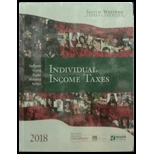
South-western Federal Taxation 2018: Individual Income Taxes
41st Edition
ISBN: 9781337385886
Author: William H. Hoffman, James C. Young, William A. Raabe, David M. Maloney, Annette Nellen
Publisher: Cengage Learning
expand_more
expand_more
format_list_bulleted
Question
Chapter 18, Problem 2DQ
To determine
Explain, if a partner, whose tax year ends on September 30, enjoys a tax benefit or a tax detriment for use of the tax year of the
Expert Solution & Answer
Want to see the full answer?
Check out a sample textbook solution
Students have asked these similar questions
Jqjwjwjwuw
I want to correct answer general accounting question
I Want Answer
Chapter 18 Solutions
South-western Federal Taxation 2018: Individual Income Taxes
Ch. 18 - Prob. 1DQCh. 18 - Prob. 2DQCh. 18 - Prob. 3DQCh. 18 - Prob. 4DQCh. 18 - Prob. 5DQCh. 18 - Prob. 7DQCh. 18 - Prob. 8DQCh. 18 - Prob. 9DQCh. 18 - Prob. 10DQCh. 18 - Prob. 12DQ
Ch. 18 - LO.2 Emerald Motors is an automobile dealer. The...Ch. 18 - Prob. 14DQCh. 18 - Prob. 15DQCh. 18 - Prob. 16DQCh. 18 - Prob. 17DQCh. 18 - Prob. 18DQCh. 18 - LO.2, 5 What are the similarities between the crop...Ch. 18 - Prob. 20DQCh. 18 - Prob. 21DQCh. 18 - Prob. 22DQCh. 18 - LO.6 Largo Company is an engineering consulting...Ch. 18 - Prob. 24DQCh. 18 - Prob. 25DQCh. 18 - Prob. 26DQCh. 18 - Prob. 27CECh. 18 - Prob. 28CECh. 18 - Prob. 29CECh. 18 - Prob. 30CECh. 18 - Prob. 31CECh. 18 - Prob. 32CECh. 18 - Prob. 33CECh. 18 - Prob. 34CECh. 18 - Prob. 37CECh. 18 - Prob. 39PCh. 18 - Prob. 40PCh. 18 - Prob. 41PCh. 18 - Prob. 42PCh. 18 - Prob. 43PCh. 18 - Prob. 44PCh. 18 - Prob. 45PCh. 18 - Prob. 46PCh. 18 - Prob. 47PCh. 18 - Prob. 48PCh. 18 - Prob. 49PCh. 18 - Jeffrey Boyd, the president of Eagle Furniture...Ch. 18 - Floyd, a cash basis taxpayer, has received an...Ch. 18 - Prob. 52PCh. 18 - Prob. 53PCh. 18 - Prob. 54PCh. 18 - Prob. 55PCh. 18 - Prob. 56PCh. 18 - Prob. 57PCh. 18 - Prob. 58PCh. 18 - Ostrich Company makes gasoline storage tanks....Ch. 18 - Prob. 61PCh. 18 - Grouse Company is a furniture retailer whose...Ch. 18 - Lavender Manufacturing Company began business in...Ch. 18 - Silver Creek Ranch LLC is a small, family-owned...Ch. 18 - Prob. 65PCh. 18 - Prob. 66PCh. 18 - Prob. 67PCh. 18 - Prob. 68PCh. 18 - Ven Company is a retailer. In 2018, its before-tax...Ch. 18 - Prob. 1RPCh. 18 - Prob. 2RPCh. 18 - Prob. 4RPCh. 18 - Paula has sales that qualify to be reported on the...
Knowledge Booster
Similar questions
arrow_back_ios
SEE MORE QUESTIONS
arrow_forward_ios
Recommended textbooks for you
 Individual Income TaxesAccountingISBN:9780357109731Author:HoffmanPublisher:CENGAGE LEARNING - CONSIGNMENT
Individual Income TaxesAccountingISBN:9780357109731Author:HoffmanPublisher:CENGAGE LEARNING - CONSIGNMENT

Individual Income Taxes
Accounting
ISBN:9780357109731
Author:Hoffman
Publisher:CENGAGE LEARNING - CONSIGNMENT




